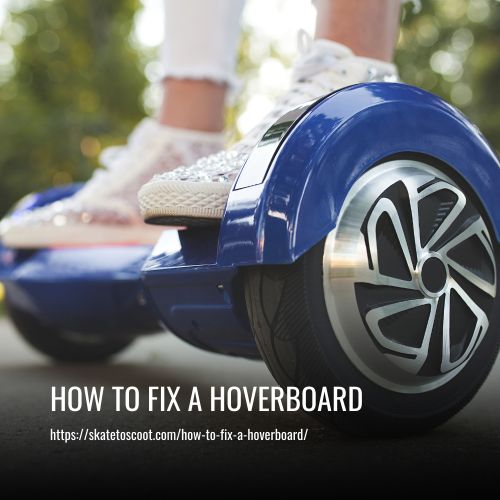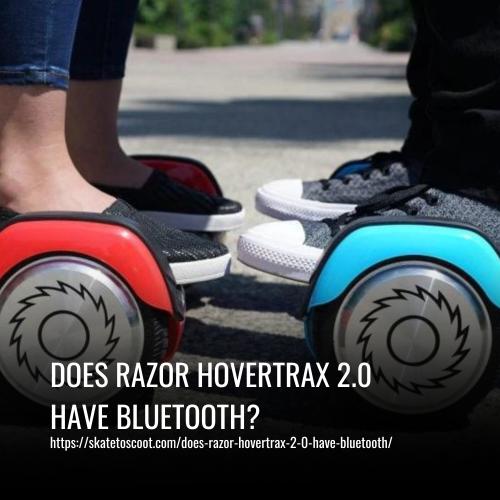As an Amazon Associate we earn from qualifying purchases.
When it comes to fixing your hoverboard, the first step is to diagnose the problem. Are you facing difficulty in turning it on? Or it’s not holding a charge? Identifying the issue will help you to figure out the steps required to fix it. Common ailments that hoverboards tend to face include faulty batteries, motor issues, and internal circuit problems, among others.
Once you’ve identified the problem, the next step is to look for quick fixes to get your hoverboard up and running. For instance, if you’re experiencing power button issues, trying a different charger or plugging it in for longer may resolve the problem. However, it’s essential to exercise caution when attempting quick fixes and ensure that they don’t cause further harm to the device.

Common Problems With Hoverboards And Their Solutions:
Hoverboard owners may experience a variety of issues, from difficulty turning on the device to not holding a charge. Some of the most common problems that hoverboard owners face include faulty batteries, motor issues, power button issues, and internal circuit problems.
1. Faulty Hoverboard Batteries
One of the common issues that hoverboard owners face is a faulty battery. While batteries are designed to last for between one to two years, they will eventually degrade and will not hold a charge. This is usually indicated by a significant decrease in battery life or a beeping red light.
Fortunately, most hoverboards are designed with easily replaceable batteries, although it’s essential to note that the process can vary depending on the model. Consequently, it’s vital to check the manufacturer’s guidelines before attempting to replace the battery.
If you encounter any issues with the replacement process, it’s recommended to check your hoverboard’s Bluetooth and motor controller. Hoverboards use Bluetooth technology to communicate with the motor controller, so any Bluetooth issues can significantly impact the hoverboard’s performance. Therefore, if you control your hoverboard with a motor controller, make sure to check the Bluetooth before attempting to fix any battery issues.
2. Broken Charging Ports:
If you notice that your hoverboard is unable to charge, check the charging port for damages. This could be due to a broken charging port which prevents the battery from receiving a charge. You will usually notice this problem when the charging light does not turn on when the hoverboard is plugged into a power source.
In this situation, you can easily repair the broken charging port yourself. Simply purchase a new charging port from a reputable vendor online and use a screwdriver and glue gun for the replacement. It is a straightforward process that you can learn easily, allowing you to get your hoverboard running smoothly again in no time.
3. Malfunctioning Sensor:
Malfunctioning sensors and gyroscopes can be a common issue with hoverboards, affecting the performance and safety of the device. This problem can arise due to regular wear and tear or heavy use. (Hoverboards employ a range of sensors and gyroscopes to provide riders with a balanced riding experience.)
If you notice that your hoverboard is no longer balancing correctly or making sudden movements, the sensors, and gyroscopes may need to be checked. One major symptom of a malfunctioning sensor is that the device might suddenly slow down or stop. (A faulty sensor may lead to sudden changes in speed or direction, leading to mishaps.)
Replacing a damaged gyroscope is a tricky and technical task; it is advisable to seek professional assistance. An expert technician or hoverboard repair service will be able to identify the fault and replace the sensor accordingly. (It is highly recommended to consult a professional hoverboard repair service if you suspect the sensors are misaligned or not functioning properly.)
4. Loose Cables:
If you’ve been using your hoverboard frequently, it’s possible that some cables inside the device might have become loose and require tightening. Fortunately, this is a simple and easy fix that any owner can do. Simply grab a screwdriver and remove the casing to gain access to the cables.
Once you have removed the casing, take a close look and locate any loose cables. Tighten these cables using a small wrench or pliers, making sure not to overtighten them as this can cause damage to the circuit board. Once you have tightened all the loose cables, replace the casing and give your hoverboard a test run to check that everything is working correctly.
5. Wheels and Motor Issues:
When using a hoverboard regularly for off-road activities, it’s not uncommon for the wheels to become chipped and damaged. This can eventually lead to issues with acceleration stability and cause a bumpy ride.
Likewise, motors can also degrade over time, which can lead to reduced power and speed. Replacing the wheels or motors can be a complicated process due to their entangled nature. It’s recommended that you seek professional help if you’re not confident in your ability to make the repairs yourself.
If the damage is simply cosmetic, you can quickly cover scratches on your hoverboard with the use of a decal or paint. However, if the problem persists, it’s vital to address the underlying issues with the wheels and motors to ensure you have a smooth and safe ride.
6. Check The Hoverboard’s Indicator (Red) Lights:
If you’re having issues with your hoverboard, one way to determine the problem is by checking its indicator (red) lights. Most hoverboards are equipped with such lights, which flash in specific patterns according to common problems. It’s like your hoverboard’s method of communicating with you.
To use this diagnostic feature, you need to observe the number of times the indicator light flashes and the pattern it makes. These patterns are typically associated with the most common issues that users experience with their hoverboards, such as defective batteries, faulty motors, bad circuit boards, and charger ports, just to name a few.
7. One Light Flashing:
A flashing red light is usually an indication of a loose wire within the hoverboard’s internal circuitry. This issue can easily be rectified, and it requires you to unscrew the outer shell with the appropriate screwdriver. Once you have access to the internal wiring, tighten any loose cables with the same screwdriver carefully.
If you are unable to locate the loose cable, disconnect all of the internal cables and reconnect them. This approach can help to ensure that all of the loose wires are adequately tightened.
8. Blinking Two or Three Times:
If you notice the red light on your hoverboard flashing two or three times in a repeated pattern, this could be a sign of a severe problem. It may suggest that the hoverboard’s circuit board is defective or malfunctioning.
To resolve this issue, you may need to replace the circuit board. Fortunately, there are circuit board replacement kits available for purchase in the market. However, keep in mind that fixing an electric hoverboard can be dangerous and complicated. Therefore, you may want to consult a professional repair service to avoid causing further damage to the device.
9. Blinking Six to Eight Times:
If the hoverboard’s light blinks six times repeatedly, it means the battery needs to be changed. While it sounds expensive, lithium batteries degrade over time, so this is always a possibility. The good news is, that a faulty battery is relatively simple to fix.
10. Wet Hoverboards:
Riding on muddy terrains or through deep puddles without proper protection could damage your hoverboard’s internal circuitry, rendering it useless. When water comes into contact with the motherboard, it could cause it to malfunction or shut down completely. In this case, you need to take immediate action to avoid further damage to your device.
If your hoverboard stops working after exposure to water, turn it off immediately, and remove the battery and motherboard. Use a soft and dry cloth to clean all components and leave them overnight to dry out. If your board is still malfunctioning, don’t despair; you can either look for replacement parts online or consult our guide on how to make a hoverboard yourself if you’re a DIY enthusiast.
Beyond fixing the problem, you can also jazz up your hoverboard to reflect your style. From different-colored LED lights to various skins or add-ons, many options exist to customize your board. With proper protection and timely action, you can avoid damaging your hoverboard, customize it to your unique taste, and safely keep riding in style.
11. Motor Circuits Are Causing Motherboard Malfunctions:
When a red light flashes four times on your hoverboard, it indicates that a malfunction is occurring on the motherboard’s wheel caused by the internal circuitry of the motor. This issue necessitates a complete replacement of the motherboard side motor. For assistance with this problem, consider taking a look at the replacement options for Hover-1 Liberty Gyroscope Sensor Boards.
12. The Hoverboard Needs to Recalibrate:
To improve an unbalanced hoverboard ride, recalibrating the system can be quite helpful. The process is simple and can even be done at home. Start by placing the hoverboard on a flat surface and press down on the power button until the LED lights on the board begin to flash.
After holding for a few seconds, turn the hoverboard off. Wait for two to five seconds, and turn it back on. The hoverboard should now be recalibrated for a smoother, more balanced ride.
13. The Hoverboard Has Loose Wires:
Hoverboards are great fun to ride, but if your hoverboard has loose wires, it can be dangerous. This issue can cause your hoverboard to malfunction, making it unable to balance properly, and it can even lead to accidents. Checking for loose wires is not difficult, but you will need to open the device to do so. You can start with the Hover-1 Liberty Bottom Cover Replacement guide to see how to remove the bottom cover of your hoverboard.
Once you have opened the device, carefully check the wires that connect the motor and motherboard. Look for any loose or disconnected wires, or broken wire harnesses. If you find any, you can try to reattach them or seek help from a professional. Loose wires will not only make your ride unstable, but they can also cause other problems like a decrease in battery life and motor issues. Fixing loose wires will keep your hoverboard running smoothly and help prevent accidents.
14. Hoverboard Has a Broken Gyroscope:
When your hoverboard has a broken gyroscope, it can cause unbalanced rides and decreased battery life. Recalibration may be a possible solution, but if this does not work, it may be time to replace the gyroscope sensor board.
You can identify the gyroscope issue through the red indicator light, which flashes 7 or 8 times to indicate which gyroscope is faulty. For the battery side gyroscope issue, it flashes 7 times while for the motherboard side, it flashes 8 times. You can view the Hover-1 Liberty Gyroscope Sensor Boards Replacement for assistance.
It is crucial to address the broken gyroscope immediately as this component is a crucial part of the hoverboard’s self-balancing mode. Attempting to ride a hoverboard with a faulty gyroscope can lead to accidents and injuries.
How To Reset A Hoverboard?
Resetting your hoverboard is a simple procedure that can potentially fix any issues you may be experiencing. Start by turning off your hoverboard and positioning both sides of the pedal parallel to the horizontal plane. Hold down the power switch for 5 seconds, then release it.
Once you hear a sound, the system will begin to calibrate, and the red driving indicator light and the left turn indicator light will flash three times. Wait for the red light to turn on, indicating that the system calibration is complete, then turn the hoverboard off and on again. With this reset process completed, most issues should be resolved.
If the reset process doesn’t work, there may be a more significant underlying issue that needs to be addressed. A faulty power button, green light, faulty battery, or other internal circuitry problems can require more advanced repairs or component replacement. Check for broken wires and loose harnesses, defective chargers, or batteries that need replacement. In some cases, it may be necessary to find a reputable hoverboard repair service or replace the hoverboard altogether if the issue goes deeper than a simple reset.
How to Fix the Hoverboard Can’t Turn On
If your hoverboard has trouble turning on, the first step is to check whether it can be charged. Look for a green light on the charger box to confirm the scooter is receiving power. If this light doesn’t turn on, it’s likely that the internal circuit of the hoverboard is damaged and needs to be replaced to make the device functional again.
However, if the green light is always on, you should then attempt to turn on the scooter. If the orange light flashes on the hoverboard, this indicates battery issues and may require a replacement for the malfunctioning part to rectify the hoverboard’s inability to turn on.
If your hoverboard keeps beeping despite your efforts to turn it off, manually taking out its battery is an option. To do this, turn the device over, unscrew it, and remove the battery slowly. Alternatively, you can leave it on a flat surface and let it run out of battery automatically, causing it to shut down.
How to Fix the Hoverboard Not Charging
When your hoverboard is not charging, it can be frustrating. However, there are a few common reasons why this might be happening, and they are relatively easy to fix.
If the charger shows a red light, just let it charge for 2-3 hours, and then you can ride your hoverboard again. But if the green light on the charger is always on, but the hoverboard cannot ride, it is likely a battery problem. A red light appears with a beeping sound when it is turned on, indicating a broken battery that needs to be replaced.
If the hoverboard cannot be opened without a charger, or it displays an orange light when powered on, it’s also a battery problem that can be solved through the second point. If the charger does not light up at all, first make sure that the three-pin plug and the charging port are completely matched. Then, check the power socket and use your laptop or mobile phone to see if there is electricity. If the socket is working properly, the charger may be broken.
How to Replace a New Battery for Hoverboard
Hoverboard batteries can degrade over time, resulting in decreased battery life and eventually the inability to charge at all. The beeping red light is a sign that the battery needs to be replaced. Fortunately, most hoverboards are designed to make the battery easy to access and replace.
To replace a hoverboard battery, start by ensuring the hoverboard is turned off and unplugged from the charger. Locate the battery compartment and remove the screws or clips holding it in place. Carefully remove the old battery, being mindful of any wires or connectors that need to be disconnected.
How to Fix the Hoverboard Pad Stuck Issue
If you’re facing the issue of a stuck pad on your hoverboard preventing it from functioning properly, don’t worry, because the solution is simple and can be done without the help of a professional.
Begin by turning off the hoverboard and unplugging it from the charger. Next, attempt to fix the issue by pushing the cushions and releasing them to see if they will spring back to their original position. However, if this initial attempt does not solve the issue, you will need to proceed with further troubleshooting steps.
How To Fix The Hoverboard Not Self-Balance Issue
When your hoverboard is not properly balanced, it can be due to several reasons. One of these reasons is that it is not in self-balancing mode. To fix this, make sure to place it on a flat surface and ensure both feet are firmly planted on the pedals for optimal detection.
Uncalibrated equipment can also lead to an unbalanced ride. To solve this, simply recalibrate the board to its initial settings. However, if the issue is a broken wire, you may need to open the circuit board and reestablish the connections. The same goes for any damaged gyroscopes, which can be resolved by replacing them.
How To Fix Vibration When You Get Off The Hoverboard
If you experience issues such as the hoverboard spinning in circles or losing control after you step off it, it’s essential to resolve the problem. To fix vibration when coming off a hoverboard, there are some easy steps you can take.
Begin by powering off the hoverboard and flipping it over to remove the back cover. Take off the back cover from the side where the vibration occurs, usually detected by pressing the foot pad with your hand. Once you have reached the inside of the hoverboard, look for a small plastic lip under the plastic casing. Using a sharp knife, cut the lip open to release the trapped air.
How to Fix Hoverboard Wheel Lock Issue
One common issue that hoverboard owners face is the wheel lock problem, which can prevent the self-balancing mode from functioning properly. To fix this problem, you need to disassemble the wheel by removing four screws. Once you have done this, carefully pull out the wheel to reveal the gasket.
The wheel lock problem typically occurs when there is damage to the self-balancing system, which can block the space and stop the motor from working smoothly. Replacing the gasket can be an effective solution to this issue. By following these steps and replacing the gasket, you can fix the hoverboard wheel lock problem and keep your self-balancing scooter running smoothly.
FAQs
A hoverboard reset is a process that helps to recalibrate the gyroscopes, which are crucial components responsible for the self-balancing mode of the board. This process completely resets the hoverboard and can help resolve issues related to unbalanced rides, power buttons, green lights, bad gyroscopes, motor issues, and a decrease in battery life.
The method to perform a full reset varies depending on the make and model of the hoverboard. Performing a reset can help in troubleshooting common hoverboard issues, and it is recommended to consult the manufacturer’s manual for instructions specific to your hoverboard model.
The flashing red lights on a hoverboard indicate potential malfunctions, including defective batteries and broken motors.
Hoverboards have multiple sensors that detect if it is laid on an incline above 15 degrees, which triggers the beep sound and stops motor function. If your hoverboard is beeping and not moving, it indicates it is on an uneven surface or too steep an incline. Relocate your hoverboard to a smooth and flat surface to reset the sensors.
If you are experiencing fast battery drainage on your hoverboard, the most probable reason would be a rapidly deteriorating battery. To solve this issue, it is recommended to purchase a new battery and replace the existing one.
When your hoverboard shakes instead of moving smoothly, it could be because of a miscommunication issue between one of the sensors and one of the motors. This can happen due to a bad gyroscope or motor issues, leading to an unbalanced ride that can be dangerous or uncomfortable. To fix this, it’s recommended to first try recalibrating your hoverboard by laying it on a flat surface and pressing the power button for a few seconds.
If this doesn’t work, check for any loose wires or broken wire harnesses that might be interrupting the communication between the sensors and the motors. If you cannot find any issues with the wiring, it may indicate a crucial component failure and you may need to seek professional repair.
Conclusion:
Fixing a hoverboard may seem daunting at first, but with the right tools and knowledge, it’s a breeze. Remember to always prioritize safety and follow the manufacturer’s instructions. With a little bit of patience and effort, you can get your hoverboard back up and running in no time. So, don’t throw it away just yet – give it a chance and fix it yourself!
Amazon and the Amazon logo are trademarks of Amazon.com, Inc, or its affiliates.



